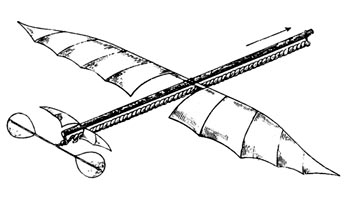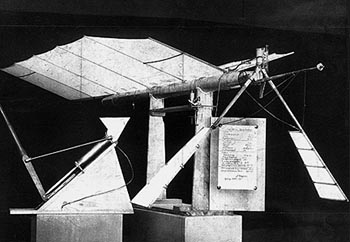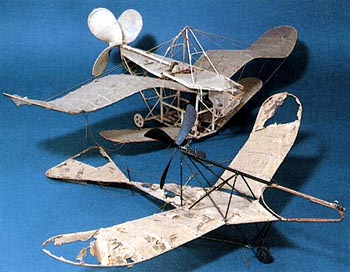
Aeromodellers of the Past 200 Years
Updated March 11, 2007
Index
George Cayley (1773-1857) - [P]
John Stringfellow (1799 - 1883)
Samuel Pierpont Langley (1834 - 1906)
Clément Ader (1841-1926)
Victor Tatin (1843 -1913)
Charles Renard (1847 - 1905)
Alphonse Pénaud (1850 - 1880) - [P]
Lawrence Hargrave (1850 -1915)
Chuhachi (Tyuuhaci) Ninomiya (1866 - 1936)
Edwin Alliot Verdon Roe (1877 - 1970)
Reginald Denny (1891 - 1967) - [P]
Sydney Camm (1893-1953)
Jack Northrop (1895 - 1981)
Reimar (1915 - 1993) and Walter Horten
Jack Douglas Hearn (1920-)
[P] incl. downloadable plans from this site.
For links to other plans first see Paul Dunlop's site Model Flying Machines
George Cayley (1773-1857)
This site regards George Cayley's seminal glider of 1804 (from a design of 1799), as the true beginning of aviation and indeed aeromodelling. With this glider he established the basic concepts of the aeroplane, concepts that in theory still hold true today. [Ed.]

George Cayley's glider, 1904 (replica)
"In 1799 Sir George Cayley (1773-1857), of Brompton, Yorkshire, England, was first to document the aerodynamic forces of flight, pitch, roll, and yaw with a diagram on a small silver disk. He was the first to realize that a cambered airfoil is more efficient than a flat surface. His 1804 glider had adjustable tail surfaces to control the direction of flight.
He tested and measured the lifting properties of various surfaces by attaching them to a whirling arm. He recognized the importance of having the wing at the correct angle in relation to the airflow (angle of attack), as well as the fact that superposed wings (bi- or triplane design) gave maximum lift with minimum structure weight." http://www.ohtm.org
Read more about George Cayley

George Cayley's glider, 1904
Download a 1/5 scale plan (1 x vertical A4 page) of Cayley's Glider of 1804
Index | Tribute Home
John Stringfellow (1799 - 1883)

John Stringfellow's model Triplane, 1868

John Stringfellow's model Triplane on display
at the Crystal Palace Exhibition, London, 1868
Read about John Stringfellow
Index | Tribute Home
Samuel Pierpont Langley (1834 - 1906)

Samuel Langley's 1896, 1/4 scale 'Aerodrome', 1903
Smithsonian
Download a 1000pixel image
Read about Langley's Aerodromes at David Dodge's site including his superb model of Langley's Aerodrome of 1903. The site also has two pages of images of Langley's rubber powered models. You can also read about Samuel Langley on this site
Index | Tribute Home
Clément Ader (1841-1926)

Clément Ader's model of the late 1880s
Download a 1000pixel image
Read about Clément Ader
Index | Tribute Home
Victor Tatin (1843 -1913)

Victor Tatin compressed air powered model, 1879
Download a 1500pixel image
Read about Victor Tatin
Index | Tribute Home
Charles Renard (1847 - 1905)

Model of the electric powered airship "La France"
Renard and Krebbs, c.1884
ftp.die.net/mirror/historic
Download a 750pixel image
Read about Charles Renard
Index | Tribute Home
Alphonse Pénaud (1850 - 1880)

Pénaud's Planaphor(e) (Planophore), 1871
Download a 1000pixel image

Pénaud's Planaphor(e) (Planophore), 1871
http://www.amars.hpg.ig.com.br
Download a half scale plan or full scale plan of the Planaphor(e) of 1871
Read about Alphonse Pénaud
Index | Tribute Home
Lawrence Hargrave (1850 -1915)

Flying Machine No.6, 1888
Single cylinder, compressed-air engine No. 12, 1890
Shaw, W. Hudson and Ruhen, Olaf, 1977, p.61
The first Australian model aircraft were built by Lawrence Hargrave in the 1880s. These compressed air models were created to test his theories on 'flapping flight' for 'man carrying' aircraft. In the first years of the 20th century he and his son Gregory (d.1915 at Gallipoli) also experimented with gasoline, rotary engined models.
Read about Lawrence Hargrave
Index | Tribute Home
Chuhachi (Tyuuhaci) Ninomiya (1866 - 1936)

Chuhachi (Tyuuhaci) Ninomiya's models, c.1893
Top Model : the 'Tamamushi' : Jewel Beetle, Gold Beetle, Gold Bug
Bottom Model : the 'Crow'
http://www.islands.ne.jp
Read about Chuhachi Ninomiya
Index | Tribute Home
Edwin Alliot Verdon Roe (1877 - 1970)

Edwin Alliot Verdon Roe's model of 1908
Download a 750pixel image
Read about AV Roe
Index | Tribute Home
Reginald Denny (1891 - 1967)

Reginald Denny and his 'Radioplane' RP-1, 1935
http://technosport.narod.ru

Reginald Denny's 'Lt'l Dennyplane Jr.' of 1938
Download a 1/2 scale plan of the 'Lt'l Dennyplane Jr.' of 1938
3 x vertical A4 pages : Page 1, Page 2, Page 3
Download a full scale plan [1.6Mb] of the 'Lt'l Dennyplane Jr.' of 1938
Read about Reginald Denny
Index | Tribute Home
Jack Northrop (1895 - 1981)

Jack Northrop's Flying Wing, Patent Model, 1939
Download a full page article incl. sketches
Read about Jack Northrop
Index | Tribute Home
Reimar (1915 - 1993) and Walter Horten

Walter Horten's model flying wing, 1929
Read about Reimar and Walter Horten
Index | Tribute Home
Sydney Camm (1893-1953)

Sydney Camm
Twin Pushers and Other Free Flight Oddities
Sir Sydney Camm lived in Windsor in his childhood at No. 10 Alma Road, with his brother Fred Camm, the Editor of the famous 'Practical...' series of magazines. His father, was an excellent carpenter and joiner and must have instilled in Sydney an interest in handwork, accuracy and quality. Before leaving The Royal Free School in 1908, aged 14, he spent hours whittling propellers for model aeroplanes. The brothers became sufficiently competent in building reliable model aeroplanes that they supplied Herberts' Eton High Street shop. Their models of biplanes and monoplanes were advertised as "Will Really Fly", and "Will Rise from the Ground".
Read more about Sydney Camm
Index | Tribute Home
Jack Douglas Hearn (1920-)

Jack Hearn
Hearn Archives
Jack Douglas Hearn was born in London, England in 1920 and arrived in Australia with his parents as a young child. His two brothers Keith and Bruce were both born in Australia. During these pre-WW2 years, apart from time spent in model construction, Jack also constructed and flew, full size gliders and sailplanes. When war broke out in 1939 Jack joined the Royal Australian Airforce (RAAF) and following his training and the gaining of his 'wings', became a commissioned officer and took up duties as flying instructor.
Read more about The Hearn Brothers
Top | Aeromodelling Home
| 


















